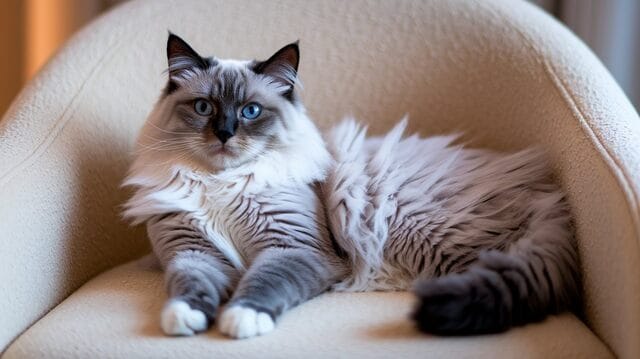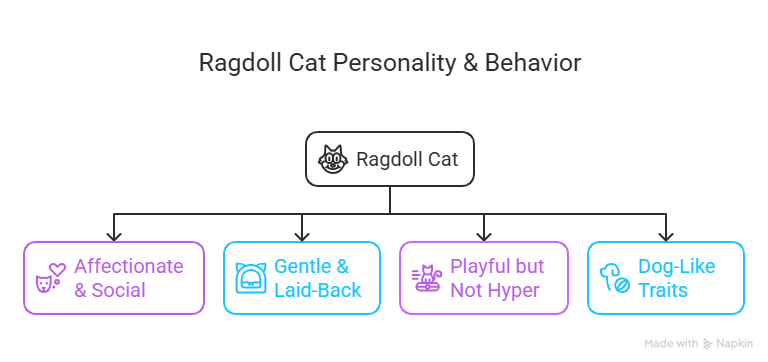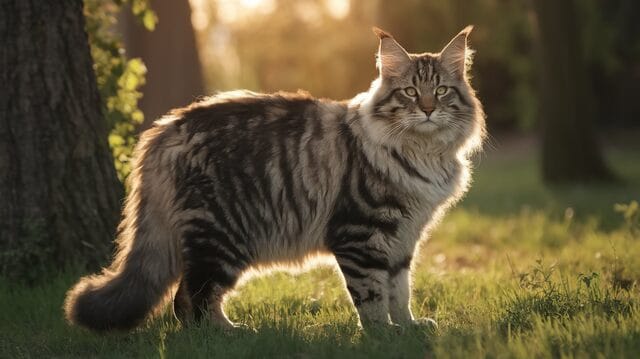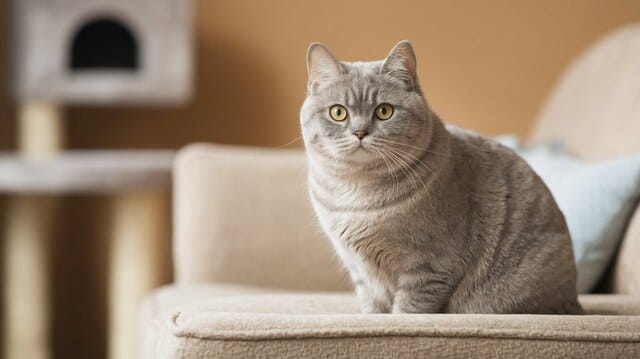
If you’re looking for a cat that loves cuddles, follows you around like a puppy, and greets you at the door, then a Ragdoll cat might be your perfect match.
Known for their stunning blue eyes, luxurious fur, and affectionate nature, Ragdolls are one of the most gentle and friendly cat breeds out there. But before bringing one home, it’s important to understand their care needs, personality, and health considerations.
Let’s dive into everything you need to know about Ragdoll cats!
History & Origins of the Ragdoll Cat
Unlike many ancient cat breeds, the Ragdoll is a relatively new breed, originating in California in the 1960s.
The First Ragdoll: Ann Baker’s Discovery
The breed was developed by Ann Baker, a breeder who noticed that one of her cats, Josephine, had incredibly relaxed and affectionate kittens. She selectively bred these kittens for their docile nature, silky fur, and striking blue eyes.
💡 Fun fact: Ragdolls were named because they tend to go limp when picked up, just like a ragdoll toy!
Ragdoll Cat Personality & Behavior

Ragdolls are often described as “puppy-like” cats because they:
✔️ Follow their owners around the house.
✔️ Greet you at the door when you come home.
✔️ Love being picked up and carried.
1. Extremely Affectionate & Social 💕
Ragdolls love human companionship and form strong bonds with their families. Unlike some independent cat breeds, Ragdolls crave attention and enjoy being around people.
💡 Tip: If you want a cat that likes to snuggle, a Ragdoll is a great choice!
2. Gentle & Laid-Back 😺
✔️ They rarely use their claws when playing.
✔️ They get along well with kids, dogs, and other pets.
✔️ They are quiet and relaxed, making them great for apartment living.
💡 Tip: Ragdolls adapt well to first-time cat owners because they are so easygoing.
3. Playful but Not Hyper 🎾
✔️ They enjoy interactive toys, puzzle feeders, and gentle play sessions.
✔️ They are not as energetic as Bengal or Abyssinian cats, but they do love playtime.
💡 Tip: A simple wand toy or ball can keep a Ragdoll entertained for hours!
4. Dog-Like Traits 🐶
✔️ Some Ragdolls learn to fetch.
✔️ Many can be trained to walk on a leash.
✔️ They enjoy socializing with their humans all day long.
💡 Tip: If you’ve always wanted a cat that acts like a dog, a Ragdoll is a great choice!
Ragdoll Cat Appearance & Coat Colors
Ragdolls are famous for their stunning blue eyes and soft, fluffy fur.
1. Beautiful Blue Eyes & Silky Fur 👀
✔️ All Ragdolls have striking blue eyes.
✔️ Their fur is semi-long, soft, and plush but lacks an undercoat, making them less prone to matting.
💡 Tip: Unlike Persian cats, Ragdolls don’t require excessive grooming—a simple brush a few times a week is enough.
2. Different Ragdoll Coat Patterns 🎨
Ragdolls come in three main coat patterns:
✔️ Colorpoint: Darker shades on ears, face, paws, and tail.
✔️ Mitted: White paws and chin with a colorpoint body.
✔️ Bicolor: White chest and belly with a symmetrical “V” on the face.
💡 Fun fact: Ragdoll kittens are born completely white and develop their colors over time!
How to Care for a Ragdoll Cat
Ragdolls are low-maintenance cats, but they do require some specific care.
1. Diet & Nutrition 🍖
✔️ High-protein diet to support muscle health.
✔️ Wet food to keep them hydrated and prevent urinary issues.
✔️ Controlled portions to prevent obesity, as they love to eat!
2. Grooming Needs 🛁
✔️ Brush 2-3 times a week to keep their coat soft.
✔️ Trim nails and clean ears regularly.
✔️ Check their fur for tangles, especially in long-haired Ragdolls.
💡 Tip: Since they don’t have an undercoat, Ragdolls shed less than some long-haired breeds.
3. Exercise & Mental Stimulation 🎾
✔️ Interactive playtime is essential to prevent boredom.
✔️ Since they’re not overly active, structured play sessions help them stay fit.
💡 Tip: Ragdolls love companionship, so consider getting a second pet if they’re alone often.
Are Ragdoll Cats Good for Families?
✔️ Great with kids – They’re patient and gentle.
✔️ Good with dogs – They’re relaxed and sociable.
✔️ Perfect for first-time owners – Easy to care for and friendly.
💡 Tip: Ragdolls should be kept indoors because they lack strong survival instincts.
Common Ragdoll Cat Health Issues
While generally healthy, Ragdolls are prone to:
🚨 Hypertrophic Cardiomyopathy (HCM) – A heart disease that should be monitored.
🚨 Urinary tract issues – Staying hydrated is key to prevention.
🚨 Obesity – Due to their relaxed nature, they need portion-controlled meals.
💡 Tip: Regular vet checkups help prevent potential health problems.
Fun Facts About Ragdoll Cats
✔️ One of the largest cat breeds – They can weigh between 10-20 lbs.
✔️ They love sleeping on their backs – It’s one of their signature behaviors.
✔️ They don’t mind being carried – Unlike most cats, they actually enjoy it!
💡 Fun fact: A Ragdoll named Tardar Sauce (Grumpy Cat) became one of the most famous internet cats ever!
FAQs About Ragdoll Cats
Q: Do Ragdolls shed a lot?
✔️ Not as much as other long-haired breeds, since they lack an undercoat.
Q: Are Ragdolls hypoallergenic?
❌ No, but they produce less dander than some breeds.
Q: Can Ragdolls be left alone?
❌ Not for long periods! They crave companionship and can get lonely.
Also Read - Do Cats Get Bored? Signs of Boredom & How to Keep Them Entertained
Final Thoughts
Ragdolls are loving, affectionate, and relaxed cats that make amazing family pets.
🐾 They love being around people and form strong bonds.
🐾 They’re playful but not overly energetic.
🐾 They’re easy to care for but need companionship!
💬 Do you have a Ragdoll? Share your experiences in the comments below! 🐱👇




